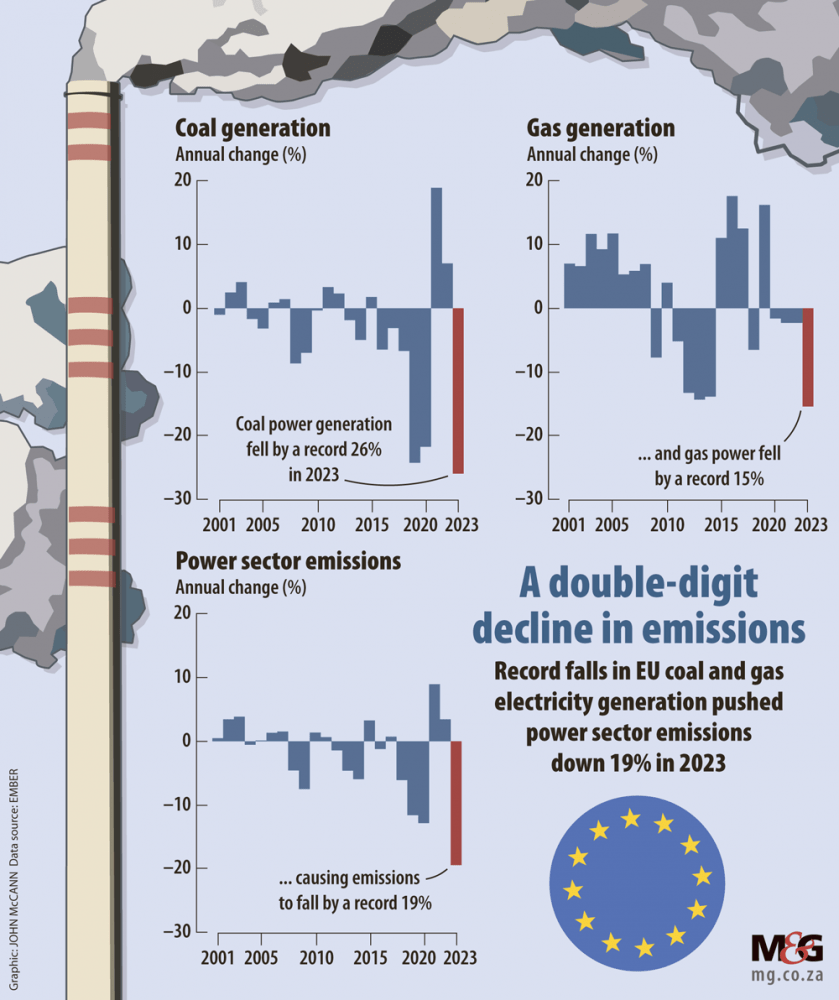South Africa needs to change its top-down approach, consult communities and fast track the delayed Integrated Energy Plan
European countries marked a major change in the source of electricity in 2023, with a significant drop in energy produced from coal and gas while that from solar and wind surged.
According to the European Electricity Review published recently by think-tank Ember, fossil fuels dropped by 19% and made up less than a third of Europe’s power for the first time. Coal displayed a major drop in generation and makes up only 12% of Europe’s electricity generation. Wind and solar contributed 27% to the European Union’s electricity.
Naturally, this led to a reduction in emissions.
There was also a drop in electricity demand, which could partially be attributed to warmer weather experienced in the region last year. But electricity grids and storage increased, which helped facilitate this renewable energy growth.
Linda Kalcher, the executive director of Strategic Perspectives, a pan-European think-tank that promotes effective climate action, said in a statement that she believes decarbonising by lowering fossil fuel use and increasing renewable energy in this way is crucial for future economic prosperity.
“Europe is building up the power mix of the future. Fossil fuels are on their way out and renewable energy is on the rise. This means a more secure and affordable access to electricity for citizens and industry, making the EU a top competitor in the zero-carbon industrial era. The trends outlined by Ember confirm that Europe has what it takes to ace the transformation needed from here to 2040 and reap its benefits.”
Bruce Douglas, the chief executive of the Global Renewables Alliance, said the growth in renewable energy must increase and not be allowed to slip.
 (Graphic: John McCann/M&G)
(Graphic: John McCann/M&G)
“This report shows the power of renewables — replacing gas and coal on the grid — with wind generating more electricity than gas in the EU for the first time ever. However, it’s vital that the EU urgently removes barriers to faster expansion. This means redirecting financial flows, fortifying supply chains, streamlining permitting processes and modernising grids.”
The report is contrary to people in South Africa’s energy space who argue that Europe is returning to fossil fuels following Russia’s invasion of Ukraine. People such as Minister of Mineral Resources and Energy Gwede Mantashe have been quoted extensively in the media using Europe as an example of why South Africa needs to stick to coal.
“The energy crisis and Russia’s invasion of Ukraine did not lead to coal and gas resurgence — far from it,” said Ember’s Europe programme director, Sarah Brown. “Coal is nearing phase-out, and as wind and solar grow, gas will be next to enter terminal decline.”
African countries do not have anywhere near the same finances or technology as their European counterparts. Western countries, which have contributed to the climate crisis, need to help the continent achieve the transition from fossil fuels to renewable energy through support mechanisms such as training, funds and technology.
Wangari Muchiri, the Africa director of the Global Wind Energy Council, said in a statement: “It is encouraging that Europe is leading the way in decarbonising the power sector, and that wind power has surpassed gas in the EU’s electricity generation. We need that leadership to trickle down to Africa in the form of finances and technological transfer into the continent’s vast renewable energy potential. Africa has the potential to become a global leader in sustainable energy, with enough capacity to foster its energy sovereignty and export the surplus.”
Recent reports that the world breached 1.5°C in the year starting February 2023 to the end of January 2024 should be a wake-up call.
It is not a complete disaster yet because that threshold needs to be cleared for several years, but it is an eye-opener. In South Africa the transition to renewable energy needs to happen with full transparency, dialogues, timelines and cohesive plans implemented in a way that protects livelihoods.
The Integrated Resource Plan, South Africa’s energy blueprint, in its current form scales down the shift to renewable energy. As the Mail & Guardian reported (“Revised Integrated Resource Plan needed ‘ASAP’, 9 January 2024): “Among the contentious elements of the draft IRP is that the plan appears to roll back the amount of wind and solar energy that will be procured compared to the 2019 iteration. The 2023 plan suggests that only 8 083 megawatts of new wind and solar capacity will come online from 2024 to 2030, while the IRP 2019 suggested 15 200MW of wind and solar would be installed during this period. The draft IRP 2023 also sets out the installation of far more gas generation capacity than was envisioned in the 2019 plan.”
Renewable energy needs to be enabled to flourish. The grid needs expanding, and technology such as batteries, solar and inverters need to be rolled out. Through appropriate financing, it is possible to achieve cleaner energy for all that doesn’t come at the cost of livelihoods.
A report by Climate Analytics, a global climate science and policy institute, found that for sub-Saharan Africa to meet energy demands and reach climate targets there needs to be a $100 billion a year in investments in renewable energy.
Africa must not be left behind in the shift to renewable energy, something Amos Wemanya, an energy leader at Power Shift Africa, feels strongly about.
“The continent’s renewable energy potential is enormous, yet it accounts for only 10% of the continent’s electricity generation mix, and only 20% of the total installed electricity generation capacity in Africa in 2019. The problem has always been the meagre financial flows which must be corrected through a radical reform of the financial architecture.”